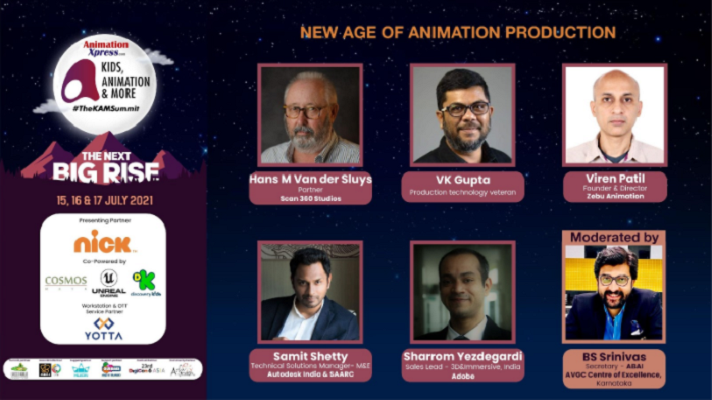
The last session on day one of the KAM Summit 2021 had an interesting topic of discussion and an enthusiastic panel of speakers.
The panel included leaders from the technology space including Autodesk India technical solutions manager Samit Shetty, Adobe sales lead Sharrom Yezdegardi, production technology veteran VK Gupta, Scan 360 Studios partner Hans M Van der Sluys, and Zebu Animation founder and director Viren Patil shared their viewpoints and solutions to expedite workflows and cutdown costs while keeping a high bar for quality and creativity and what are the new innovations being offered by the software companies. The session was moderated by AVGC Centre of Excellence, Karnataka and ABAI secretary BS Srinivas.
“New age production is very demanding. In the last one or two years, the consumption of animation has doubled. So, in order to achieve it, a lot of companies are collaborating to get things done faster. New age production doesn’t only mean saving time, it also means saving money. You no longer have to invest in multiple tools and plugins,” said Samit Shetty.
“The audience has become more judicious. They are expecting more high-quality content and the evolution of technology is playing a big role. Technology is slowly evolving to a point where it’s beginning to become invisible, which is fantastic. And the fact that technology is evolving so much is awesome,” added Viren Patil.
With live-action shoots limited or facing new restrictions, 2020 brought a wave of standout animated ads from various brands. Even before the pandemic, technological innovations were helping to usher in new talent and techniques across animation. The changes have led some animators to suggest that they are entering a golden age for their craft. One example of this is development in real-time animation, the process of using a motion-capture system to puppeteer a 3D character live, which has moved past “gamey or visually non-pleasing graphics.”
“Motion capture will play a more and more important role in television, animation series, and films. As competition power increases, we will be able to use animation in production in real-time. By using motion capture with different software like Motion Builder, Unreal Engine, and Maya, you can do real-time stuff. I would strongly urge everyone to experiment, to at least give it a try,” urged Hans M Van der Sluys.
Sharrom Yezdegardi added, “Immersive media is no more the future, it’s actually the present. It’s right here. It’s going beyond the industries. When it comes to the future of the animation, VFX, and video-gaming industry, more and more artists want reduced requirements of jumping from one app to the other to convert file formats and better collaborative tools.”
Marketers are already trying to be more conversational in the digital realm. The “faster turnaround” of real-time animation has the potential to make such interactions more playful and creative, and allow brands to stand out when reacting to daily news or social-media trends. We’re seeing audience and distribution change, which will fundamentally realign the economy and animation, but we’re also seeing technical innovation. These are fairly magical things to be happening at once, and so it wouldn’t be too melodramatic to call it a golden age of animation.
“As technology improves, you don’t need to train the tools. Tools become much easier. It is about skills only since the software doesn’t require teaching anymore. Technology has come to a point where you can again become an artist now. Earlier technology was painful because data sets were locked into software and a lot of collaborative tools had to be built. But now, it is the best time to become an artist. I guess that’s the reason why I call myself the veteran of production technology,” laughed VK Gupta.
Moderator BS Srinivas mentioned, “Content consumption and content creation has increased post the pandemic; thanks to esports, gaming, and the OTT platforms.”
In conclusion, all the panellists jointly agreed to the fact that now the technology has evolved to such an extent that creativity must keep pace with it.
Watch the entire session here from 3:00:47

